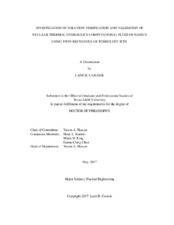| dc.contributor.advisor | Hassan, Yassin A | |
| dc.creator | Carasik, Lane B | |
| dc.date.accessioned | 2020-02-21T16:22:38Z | |
| dc.date.available | 2020-02-21T16:22:38Z | |
| dc.date.created | 2017-05 | |
| dc.date.issued | 2017-05-10 | |
| dc.date.submitted | May 2017 | |
| dc.identifier.uri | https://hdl.handle.net/1969.1/187181 | |
| dc.description.abstract | The research and development of advanced nuclear reactors requires complementary experimental and computational approaches. These approaches are used in such a manner that experimental campaigns help validate computational tools. These computational tools are then utilized for similar scenarios where experimental efforts would be prohibitive due to variety of reasons including cost. Advanced reactor designs, such as sodium fast reactors, very high temperature reactors, and molten salt reactors motivate this work due to the exotic coolants used. The exotic coolants require surrogate experiments for fluids of specific thermal physical properties to mirror their properties.
There are established standards of verification and validation methods that are broken up into code and solution (also known as calculational) pathways. Code verification and validation is in the realm of the code developer while solution verification and validation is in the realm of the user. The current work reported is focused on the later and tries to do so without any assumptions regarding code verification and validation. The work conducted focuses on a case study to show an alternate means of solution verification that is pursued without restrictive methods such as Grid Convergence Index and its variants. It is not meant to be a rigorous means of developing error bands (uncertainty bands) for realistic computational fluid dynamics analysis (including 3-D effects such as turbulence) though there is an attempt to do so. The sample case study provides future users an approach to determine if their computational fluid dynamics studies are sufficient without the aforementioned methods (i.e. mesh convergence without a commentary on the error bands).
The case study used in this work is based on twin planar-like turbulent jets exhausting into a large volume of fluid. The two jets combine into a single turbulent free shear planar jet which can be shown through velocity, vorticity, and Reynolds stress information in the areas of interest. The simulations used to model this case are done using the computational fluid dynamics code, Star-CCM+. Based on this effort, a simple mesh convergence methodology is proposed and a solution validation analysis was conducted. The computational fluid dynamics simulations were shown to have reasonable agreement with the experimental works within the Twin Jet Water Facility. It is hoped this work will help provide an alternate pathway for code users of computational fluid dynamics tools to do simple and effective solution verification and validation. | en |
| dc.format.mimetype | application/pdf | |
| dc.language.iso | en | |
| dc.subject | CFD | en |
| dc.subject | Solution Verification and Validation | en |
| dc.subject | RANS | en |
| dc.subject | Twin Jets | en |
| dc.title | Investigation of Solution Verification and Validation of Nuclear Thermal Hydraulics Computational Fluid Dynamics Using Twin Rectangular Turbulent Jets | en |
| dc.type | Thesis | en |
| thesis.degree.department | Nuclear Engineering | en |
| thesis.degree.discipline | Nuclear Engineering | en |
| thesis.degree.grantor | Texas A&M University | en |
| thesis.degree.name | Doctor of Philosophy | en |
| thesis.degree.level | Doctoral | en |
| dc.contributor.committeeMember | Kimber, Mark L | |
| dc.contributor.committeeMember | King, Maria D | |
| dc.contributor.committeeMember | Chen, Hamn-Ching | |
| dc.type.material | text | en |
| dc.date.updated | 2020-02-21T16:22:39Z | |
| local.etdauthor.orcid | 0000-0002-4235-4697 | |


